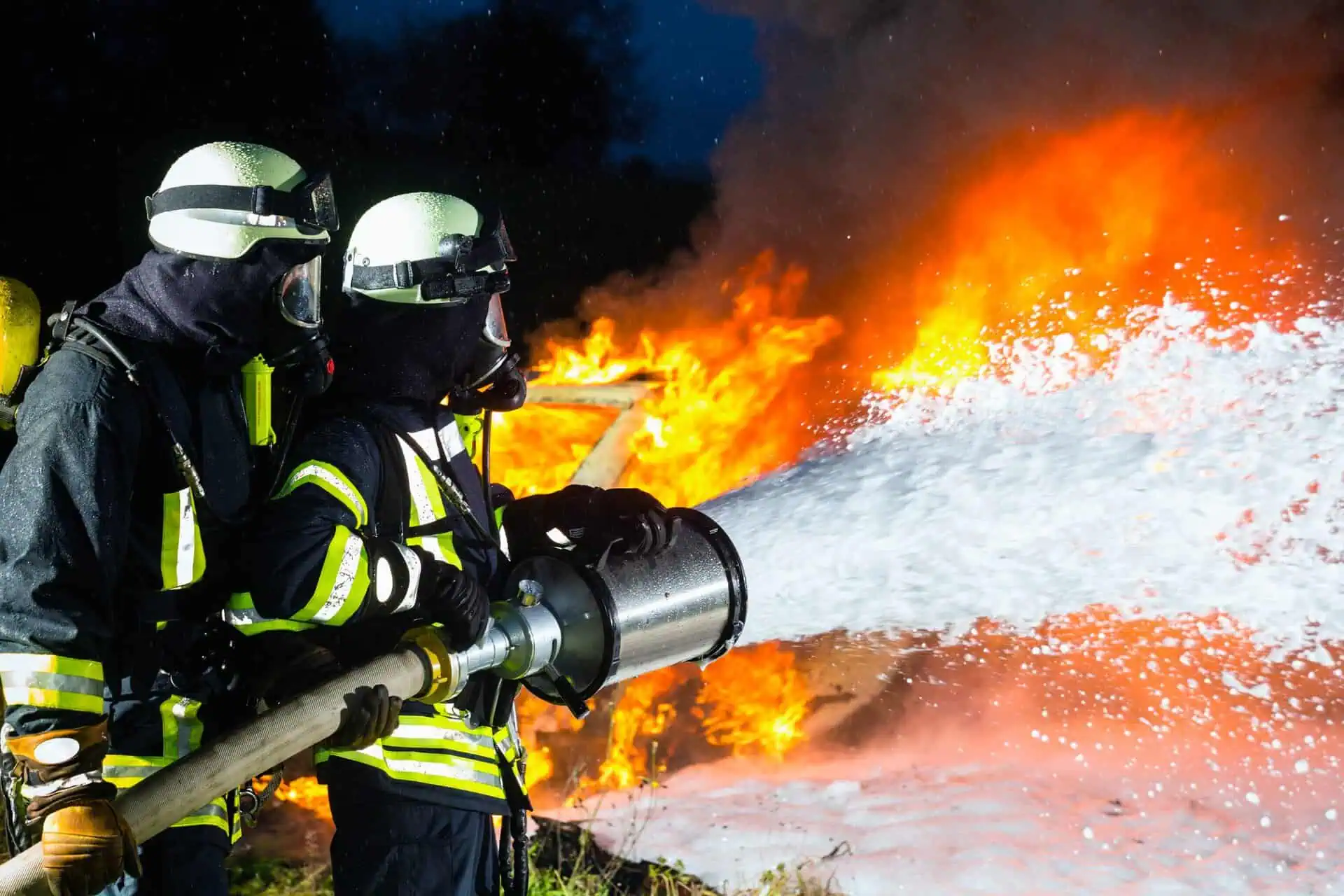FAQ: Will There Be an AFFF Foam Settlement in 2024?
- Last Updated: July 14th, 2025

Attorney Jessica Paluch-Hoerman, founder of TruLaw, has over 28 years of experience as a personal injury and mass tort attorney, and previously worked as an international tax attorney at Deloitte. Jessie collaborates with attorneys nationwide — enabling her to share reliable, up-to-date legal information with our readers.
Legally Reviewed
This article has been written and reviewed for legal accuracy and clarity by the team of writers and legal experts at TruLaw and is as accurate as possible. This content should not be taken as legal advice from an attorney. If you would like to learn more about our owner and experienced injury lawyer, Jessie Paluch, you can do so here.
Fact-Checked
TruLaw does everything possible to make sure the information in this article is up to date and accurate. If you need specific legal advice about your case, contact us by using the chat on the bottom of this page. This article should not be taken as advice from an attorney.
Key takeaways:
- AFFF, or Aqueous Film-Forming Foam, is a fire suppressant widely used by the navy, firefighters, and military to suppress fires involving flammable liquids such as gasoline and oil.
- PFAS have been linked to various health problems, including cancer, reproductive issues, liver damage, immune system dysfunction, and hormonal disruptions. This has led to a class action lawsuit involving firefighters and water contamination.
- Firefighting foam exposure linked to these types of diseases may qualify for AFFF lawsuit compensation.
Will There Be an AFFF Foam Settlement in 2024?
Question: Will there be an AFFF foam settlement in 2024?
Answer: As of the latest updates in 2024, there is no set timeline for a global AFFF foam settlement.
Although there have been some partial settlements and continued negotiations, an agreement that addresses all plaintiffs and defendants has yet to be reached.
It’s important to remember that the legal process for these cases can be lengthy.
Various factors, such as the strength of the evidence, negotiations between parties, and court decisions, will influence the outcome of the AFFF lawsuits.
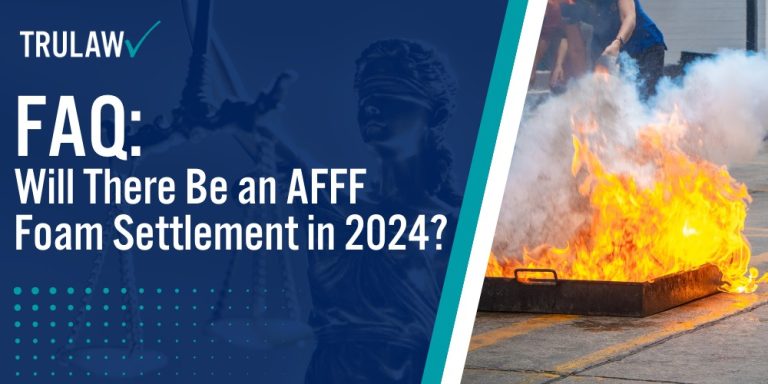
Overview of AFFF Lawsuit Settlements: Firefighting Foam Linked to Health Issues
AFFF firefighting foam contains PFAS chemicals, which have been associated with cancer diagnoses and other serious health problems.
Those affected by AFFF exposure are encouraged to consider filing an AFFF lawsuit to seek compensation for their health conditions and damages.
If you or a loved one has experienced adverse effects from firefighting foam exposure, we invite you to reach out to TruLaw for a free consultation.
You can use the chatbot on this page to instantly determine if you qualify to file an AFFF Lawsuit based on the specifics of your case.
If you are exploring the possibility of filing an AFFF lawsuit, you may be curious about potential settlement amounts.
Below, we provide an overview of possible AFFF lawsuit settlement amounts based on previous cases.
Please note, the figures mentioned are not guarantees of specific outcomes for individual lawsuits.
These are estimates drawn from prior mass tort cases involving AFFF firefighting foam.
Table of Contents
What Are the Expected Settlement Amounts for AFFF Lawsuits?
As we’ll discuss further in this article, the potential settlement amounts for AFFF firefighting foam lawsuits depend on several factors.
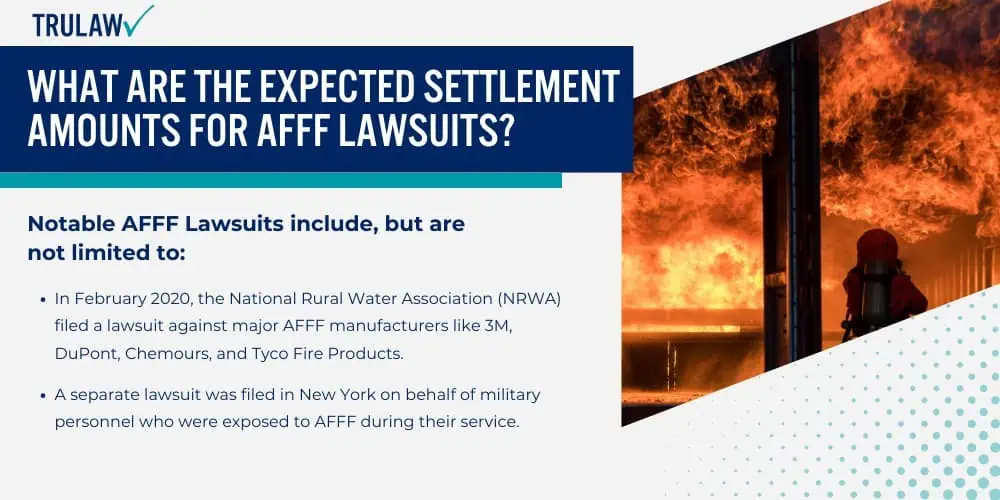
To build a successful AFFF lawsuit, plaintiffs must provide detailed evidence of exposure to the foam, medical documentation of treatments, and other related information to support their claims.
No settlements have been finalized in the AFFF litigation yet, but AFFF lawyers believe that settlement amounts could range from $20,000 to $600,000 (or more), based on the details and individual circumstances of each case.
These estimates are not guaranteed and are based on previous mass tort cases and settlements involving cancer diagnoses.
The final compensation will vary depending on the unique details of each case.
Previous Settlement Amounts in AFFF Firefighting Foam Lawsuits
AFFF lawsuits have been filed on behalf of individuals exposed to firefighting foam either through occupational contact or environmental contamination.
While specific AFFF-related settlements are still pending, previous lawsuits involving PFAS contamination offer some insight into potential outcomes.
For instance, in March 2020, a court ordered DuPont to pay $50 million to a testicular cancer victim who had been exposed to PFAS chemicals through contaminated drinking water.
The lawsuit claimed the victim’s diagnosis was linked to PFAS seepage into the water supply from AFFF.
Notable AFFF Lawsuits include, but are not limited to:
- In February 2020, the National Rural Water Association (NRWA) initiated a lawsuit against leading AFFF manufacturers, including 3M, DuPont, Chemours, and Tyco Fire Products. The lawsuit alleged that these companies knowingly produced and sold products containing harmful PFAS chemicals, which have had adverse effects on humans, animals, and the environment.
- A separate lawsuit was filed in New York on behalf of military personnel who were exposed to AFFF during their service. This case also names several AFFF manufacturers, including 3M, DuPont, Chemours, and Tyco Fire Products, among others.
Historical Settlement Amounts in PFAS Contamination Cases
Lawsuits related to PFAS contamination in drinking water have led to settlements:
- In September 2022, 3M and Wolverine Worldwide reached a $54 million settlement in a PFAS lawsuit involving residents of Kent County, Michigan.
- In February 2017, DuPont agreed to a $671 million settlement to resolve thousands of lawsuits connected to PFAS contamination in West Virginia waterways.
Factors Affecting AFFF Lawsuit Settlement Amounts
Although some AFFF firefighting foam lawsuits have led to settlements in the past, the potential settlement amounts in each case can vary significantly, depending on the strength of the claim and individual circumstances.
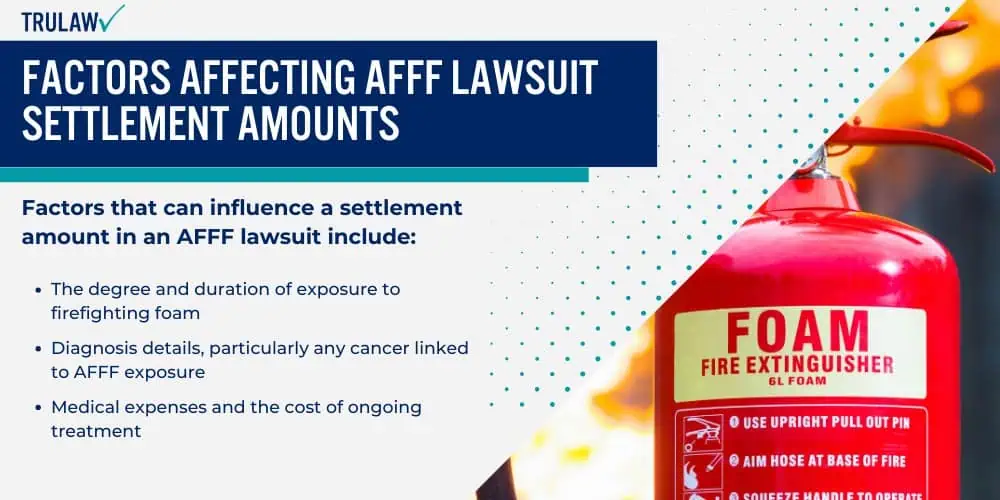
Factors that can influence a settlement amount in an AFFF lawsuit include:
- The degree and duration of exposure to firefighting foam
- Diagnosis details, particularly any cancer linked to AFFF exposure
- Medical expenses and the cost of ongoing treatment
- Other compensatory or punitive damages related to the case
The overall strength of an AFFF lawsuit is determined by the evidence gathered, the extent of the damages calculated, and the liability established by the legal team.
Importance of Evidence in Firefighting Foam Lawsuits
In AFFF lawsuits, gathering the right evidence is important to the success of a claim.
Documented evidence can impact the outcome of the settlement process.
Evidence in AFFF firefighting foam lawsuits may include:
- Details of cancer diagnosis or other related health conditions
- Medical records
- Documentation of AFFF exposure sites
- Employment history or records of AFFF exposure
- Testimonies from individuals or witnesses
- Any other proof validating exposure to firefighting foam
Compensation for Damages in AFFF Lawsuits
Damages refer to the various losses, both economic and non-economic, that individuals may have suffered due to AFFF exposure.
These can range from medical bills to the broader impacts on quality of life.
Damages in AFFF firefighting foam lawsuits may include:
- Medical costs, including treatment and therapies
- Lost wages due to inability to work
- Emotional distress, pain, and suffering
- Reduced earning capacity
- Diminished quality of life
- Permanent disability or impairment
- Anticipated future medical expenses
- Loss of companionship or support
Establishing Liability in AFFF Firefighting Foam Lawsuits
Establishing liability is a key component in an AFFF lawsuit.
The experienced firefighting foam lawyers at TruLaw and our partner law firms will work to identify the companies responsible for manufacturing or distributing the firefighting foam that led to the harmful exposure cited in these cases.
Many companies have been involved in AFFF lawsuits, with several being held accountable for their role in producing these harmful chemicals.
These companies include, but are not limited to:
- Chemguard Inc.
- DuPont de Nemours Inc.
- Tyco Fire Products
- 3M
- Other AFFF manufacturers
Liability is determined based on the evidence gathered and the circumstances of the exposure.
The AFFF firefighting foam lawyers at TruLaw and our partner firms work diligently to build strong AFFF firefighting foam cases that seek compensation from those responsible for damages caused by their AFFF products.
Use the chat on this page for an instant case evaluation to determine if you qualify to file an AFFF cancer lawsuit.
Health Issues Experienced by AFFF Foam Exposure Victims
Aqueous Film Forming Foam (AFFF) has been extensively used by fire departments, military bases, and airports to combat highly flammable liquid fires, such as those involving oil, gasoline, and jet fuel.
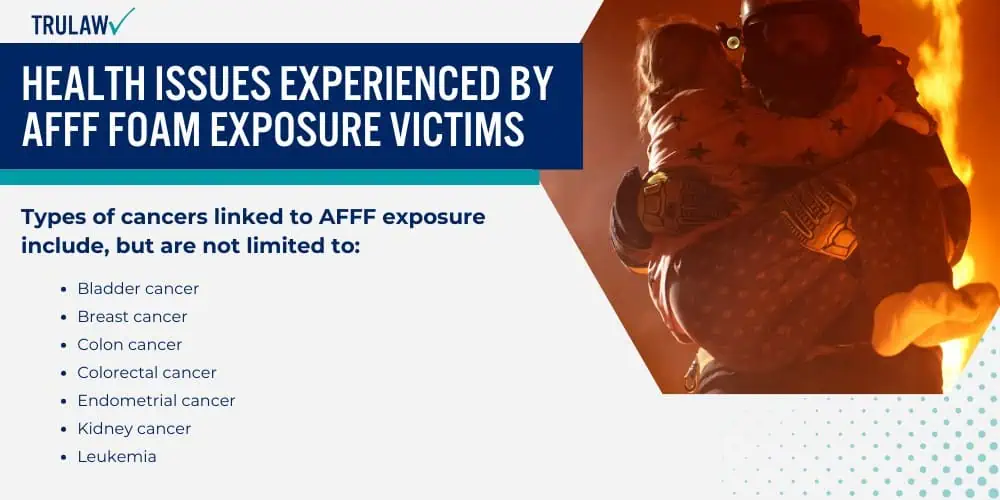
Since its introduction in the 1970s, AFFF has served as a powerful fire suppressant, though its use has diminished in many firefighting operations today.
However, in some high-risk situations, AFFF is still in use.
AFFF contains PFAS chemicals, commonly known as “forever chemicals,” because they remain in the environment and the human body for extended periods without breaking down.
These chemicals have been linked to a range of health concerns.
PFAS contamination has been associated with numerous health effects, including:
Cancer Diagnoses Linked to AFFF Exposure
Thyroid cancer, bladder cancer, and various other forms of cancer diagnoses have been linked to long-term AFFF firefighting foam exposure.
Types of cancers linked to AFFF exposure include, but are not limited to:
- Bladder cancer
- Breast cancer
- Colon cancer
- Colorectal cancer
- Endometrial cancer
- Kidney cancer
- Leukemia
- Liver cancer
- Lymphoma
- Mesothelioma
- Multiple Myeloma
- Non-Hodgkin Lymphoma
- Ovarian cancer
- Pancreatic cancer
- Prostate cancer
- Rectal cancer
- Testicular cancer
- Thyroid cancer
Other Health Issues Associated with AFFF Foam
Other health issues linked to AFFF exposure include, but are not limited to:
- Thyroid disease
- Ulcerative Colitis
- Birth defects and other reproductive issues
- Developmental problems
- Heart disease
- Hormonal imbalances
- Immune system disorders
- Increased cholesterol levels
- Increased risk of high blood pressure or pre-eclampsia in pregnant women
- Liver damage and changes in liver enzymes
- Neuroendocrine tumors
- Reproductive issues
- Skin and eye irritation
- Other health complications
At TruLaw, we recognize the serious health challenges faced by individuals exposed to AFFF and its harmful chemicals.
We are actively working to help those affected explore their legal options and seek potential compensation for health complications related to AFFF exposure.
TruLaw: Your Firefighting Foam Cancer Law Firm
At TruLaw, we are actively accepting clients for AFFF lawsuits across all 50 states.
It’s important to note that TruLaw is only accepting clients with AFFF personal injury claims — we are not accepting clients for the AFFF municipal water contamination cases.
We understand the challenges faced by individuals dealing with health issues potentially linked to long-term exposure to harmful chemicals in firefighting foam.
If you or a loved one have been diagnosed with cancer or experienced other health problems after consistent exposure to AFFF firefighting foam, you may be eligible to file an AFFF Firefighting Foam Lawsuit.
Use the chat on this page for an instant case evaluation to determine if you qualify to file an AFFF lawsuit.
AFFF Lawsuit Frequently Asked Questions
-
If you or a loved one were exposed to firefighting foam, you may be eligible to file an AFFF exposure lawsuit.
The AFFF MDL (MDL 2873) brings together AFFF cancer lawsuits from across the nation, where plaintiffs claim cancer diagnoses or other injuries resulting from AFFF exposure.
To find out if you qualify instantly, you can use the chatbot on this page.
For more details, visit our main AFFF Lawsuit page here.
-
A variety of individuals may have faced exposure to toxic PFAS chemicals in firefighting foam.
Those most at risk include:
- Firefighters
- Airport workers
- Industrial workers
- Military personnel involved in firefighting
- Oil industry workers
These groups may have suffered from occupational exposure to AFFF through direct contact or inhalation of toxic fumes.
Additionally, others may have been exposed through contaminated drinking water in areas where firefighting foam was used, such as near military bases and airports.
-
The AFFF Multidistrict Litigation (MDL) involves the consolidation of firefighting foam cancer lawsuits in the U.S. District Court for the District of South Carolina.
The lawsuits consolidated in this MDL involve claims alleging:
- Contamination of groundwater near military bases, airports, and industrial sites where AFFF was used to extinguish liquid fuel fires.
- Exposure to PFAS chemicals, especially perfluorooctanoic acid (PFOA) and perfluorooctane sulfonate (PFOS), which are present in AFFF products.
- Personal injuries, medical monitoring needs, property damage, and economic losses due to exposure to AFFF.
It’s important to note that the AFFF MDL is not the same as a AFFF class action lawsuit.
While you may see other law firms refer to this as the AFFF firefighting foam class action lawsuit, this is incorrect.
In an MDL, settlements are awarded individually to claimants based on their specific circumstances — whereas class action lawsuits distribute a single settlement equally among all participants.

Managing Attorney & Owner
With over 25 years of legal experience, Jessica Paluch-Hoerman is an Illinois lawyer, a CPA, and a mother of three. She spent the first decade of her career working as an international tax attorney at Deloitte.
In 2009, Jessie co-founded her own law firm with her husband – which has scaled to over 30 employees since its conception.
In 2016, Jessie founded TruLaw, which allows her to collaborate with attorneys and legal experts across the United States on a daily basis. This hypervaluable network of experts is what enables her to share the most reliable, accurate, and up-to-date legal information with our readers!
Additional AFFF Lawsuit resources on our website:
Here, at TruLaw, we’re committed to helping victims get the justice they deserve.
Alongside our partner law firms, we have successfully collected over $3 Billion in verdicts and settlements on behalf of injured individuals.
Would you like our help?
At TruLaw, we fiercely combat corporations that endanger individuals’ well-being. If you’ve suffered injuries and believe these well-funded entities should be held accountable, we’re here for you.
With TruLaw, you gain access to successful and seasoned lawyers who maximize your chances of success. Our lawyers invest in you—they do not receive a dime until your lawsuit reaches a successful resolution!
AFFF Lawsuit claims are being filed against manufacturers of aqueous film-forming foam (AFFF), commonly used in firefighting.
Claims allege that companies such as 3M, DuPont, and Tyco Fire Products failed to adequately warn users about the potential dangers of AFFF exposure — including increased risks of various cancers and diseases.
Depo Provera Lawsuit claims are being filed by individuals who allege they developed meningioma (a type of brain tumor) after receiving Depo-Provera birth control injections.
A 2024 study found that women using Depo-Provera for at least 1 year are five times more likely to develop meningioma brain tumors compared to those not using the drug.
Suboxone Tooth Decay Lawsuit claims are being filed against Indivior, the manufacturer of Suboxone, a medication used to treat opioid addiction.
Claims allege that Indivior failed to adequately warn users about the potential dangers of severe tooth decay and dental injuries associated with Suboxone’s sublingual film version.
Social Media Harm Lawsuits are being filed against social media companies for allegedly causing mental health issues in children and teens.
Claims allege that companies like Meta, Google, ByteDance, and Snap designed addictive platforms that led to anxiety, depression, and other mental health issues without adequately warning users or parents.
Transvaginal Mesh Lawsuits are being filed against manufacturers of transvaginal mesh products used to treat pelvic organ prolapse (POP) and stress urinary incontinence (SUI).
Claims allege that companies like Ethicon, C.R. Bard, and Boston Scientific failed to adequately warn about potential dangers — including erosion, pain, and infection.
Bair Hugger Warming Blanket Lawsuits involve claims against 3M — alleging their surgical warming blankets caused severe infections and complications (particularly in hip and knee replacement surgeries).
Plaintiffs claim 3M failed to warn about potential risks — despite knowing about increased risk of deep joint infections since 2011.
Baby Formula NEC Lawsuit claims are being filed against manufacturers of cow’s milk-based baby formula products.
Claims allege that companies like Abbott Laboratories (Similac) and Mead Johnson & Company (Enfamil) failed to warn about the increased risk of necrotizing enterocolitis (NEC) in premature infants.
Here, at TruLaw, we’re committed to helping victims get the justice they deserve.
Alongside our partner law firms, we have successfully collected over $3 Billion in verdicts and settlements on behalf of injured individuals.
Would you like our help?
